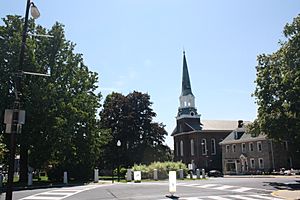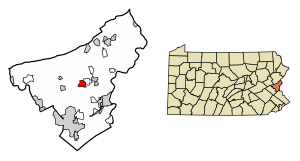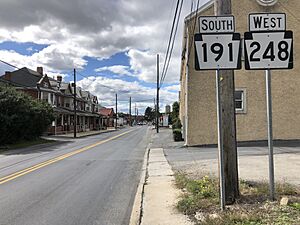Nazareth, Pennsylvania facts for kids
Quick facts for kids
Nazareth
|
||
|---|---|---|

Center Square in Nazareth in August 2013
|
||
|
||

Location of Nazareth in Northampton County, Pennsylvania (left) and of Northampton County in Pennsylvania (right)
|
||
| Country | ||
| State | ||
| County | Northampton | |
| Founded | 1740 | |
| Area | ||
| • City | 1.67 sq mi (4.32 km2) | |
| • Land | 1.58 sq mi (4.11 km2) | |
| • Water | 0.08 sq mi (0.22 km2) | |
| Elevation | 492 ft (150 m) | |
| Population
(2020)
|
||
| • City | 6,053 | |
| • Density | 3,818.93/sq mi (1,474.26/km2) | |
| • Metro | 865,310 (US: 68th) | |
| Time zone | UTC-5 (EST) | |
| • Summer (DST) | UTC-4 (EDT) | |
| ZIP Code |
18064
|
|
| Area codes | 610 and 484 | |
| FIPS code | 42-52808 | |
| Primary airport | Lehigh Valley International Airport | |
| Major hospital | Lehigh Valley Hospital–Cedar Crest | |
| School district | Nazareth Area | |
Nazareth is a small town, called a borough, in Northampton County, Pennsylvania, United States. In 2020, about 6,053 people lived there. Nazareth is part of the larger Lehigh Valley area, which is home to over 860,000 people.
Contents
History of Nazareth
Why is it called Nazareth?
The town of Nazareth is named after the Biblical town of Nazareth in Israel. This is where Jesus grew up. Many other places in the Lehigh Valley area of Pennsylvania also have names inspired by the Bible. These include Bethlehem, Emmaus, and Egypt. Even Allentown's Jordan Creek is named after a river in the Middle East.
Early Days: 1700s and 1800s
Nazareth was started in 1740 by Moravian immigrants from Germany. The land for Nazareth was bought from a preacher named George Whitefield. The Moravians built the Whitefield House, which is still there today.
At first, Nazareth was a special Moravian community. Only people of the Moravian faith could buy land there. It was one of four main Moravian towns in the early Thirteen Colonies. The other three were Bethlehem, Emmaus, and Lititz, all in Pennsylvania.
In 1735, some Moravian missionaries went to Savannah, Georgia. They wanted to teach Native American tribes and help the settlers. But the Moravians, like the Quakers, refused to fight in a war with the Spanish. Because of this, they were asked to leave Georgia in 1739.
George Whitefield, a famous preacher, brought these Moravians to Philadelphia. Whitefield had big plans to build a school for Black children on his land, which he called the Barony of Nazareth. He hired the Moravians to help build this school.
By June 1739, the first log house was built. The workers faced tough weather, and winter came quickly. They built a second log house. After it was done, Whitefield had disagreements with the Moravians and told them to leave.
While the Moravians were away, their leaders in England worked to buy the entire Barony. Whitefield's business manager died, and Whitefield realized he couldn't afford his Nazareth plans. So, he had to sell the land. On July 16, 1741, the land officially became Moravian property.
Nazareth was first meant to be an English-speaking village. But in October 1742, its 18 English residents left for Philadelphia. This left Nazareth mostly with Captain John, a Lenape chieftain, and his people. They didn't want to leave, even though they no longer owned the land.
In December 1742, Count Zinzendorf, a Moravian leader, made a deal with Captain John. His tribe then moved back to their original lands.
In 1743, the Whitefield House was made ready for 32 young married couples from Europe. On January 2, 1744, these couples traveled to Nazareth to live in the house. Today, the Whitefield House and the nearby Gray Cottage belong to the Moravian Historical Society.
As more people moved to Nazareth, the town grew. Many visitors came, so the Rose Inn was built in 1752. Two years later, in 1754, Nazareth Hall was built. People hoped Count Zinzendorf would return and live there, but he never came back to America.
In 1759, Nazareth Hall became a boarding school for Moravian boys. It became famous as a "classical academy." This led to the start of Moravian College and Theological Seminary in 1807, which is now in Bethlehem. The Nazareth Hall Tract was added to the National Register of Historic Places in 1980.
Nazareth in the 1900s and 2000s
Until the mid-1900s, many people in Nazareth were of German background. They were known as the Pennsylvania Dutch. The word "Dutch" comes from "Deutsch," which means "German." Many Pennsylvania Dutch also came from Switzerland and the Alsace region of France.
The town's churches showed its German roots. There were Moravian, Lutheran, Reformed, and Roman Catholic churches. Nazareth also had many Italian and Polish residents. They often attended Holy Family Catholic Church.
In the late 1900s, many people moved to eastern Pennsylvania from New Jersey and New York. This caused Nazareth's population to grow a lot. Builders from New Jersey moved their projects to Pennsylvania because of fewer rules there.
This building boom was helped by new highways. The interstate system, started in the 1950s, made travel easier. Near Nazareth, Pennsylvania Route 33 was completed. This road connects Interstate 78, U.S. Route 22, and Interstate 80. These roads run east and west. Interstate 78 also connected the Lehigh Valley to New Jersey and New York City to the east. It also connected to Harrisburg and Pittsburgh to the west.
The Nazareth Historic District was added to the National Register of Historic Places in 1988.
People of Nazareth
| Historical population | |||
|---|---|---|---|
| Census | Pop. | %± | |
| 1860 | 781 | — | |
| 1870 | 949 | 21.5% | |
| 1880 | 984 | 3.7% | |
| 1890 | 1,318 | 33.9% | |
| 1900 | 2,304 | 74.8% | |
| 1910 | 3,978 | 72.7% | |
| 1920 | 4,288 | 7.8% | |
| 1930 | 5,505 | 28.4% | |
| 1940 | 5,721 | 3.9% | |
| 1950 | 5,830 | 1.9% | |
| 1960 | 6,209 | 6.5% | |
| 1970 | 5,815 | −6.3% | |
| 1980 | 5,443 | −6.4% | |
| 1990 | 5,713 | 5.0% | |
| 2000 | 6,023 | 5.4% | |
| 2010 | 5,746 | −4.6% | |
| 2020 | 6,053 | 5.3% | |
| Sources: | |||
In 2000, there were 6,023 people living in Nazareth. There were 2,560 households, and 1,515 families. Most people (98.46%) were White. About 0.55% were African American, and 0.40% were Asian. About 0.95% of the population was Hispanic or Latino.
About 25% of households had children under 18. Almost half (47.1%) were married couples living together. The average household had 2.22 people. The average family had 2.89 people. The population was spread out by age. About 20.2% were under 18, and 24.4% were 65 or older. The average age was 41 years old.
Geography and Climate
Nazareth is located at 40°44′24″N 75°18′40″W / 40.74000°N 75.31111°W. It covers about 1.7 square miles (4.32 square kilometers) of land.
Nazareth has a climate similar to the rest of the Lehigh Valley. It has four clear seasons. Summers are humid, and winters are cold. Spring and fall are usually short and mild. The climate is called "hot-summer humid continental." Average monthly temperatures range from 28.1°F (-2.2°C) in January to 73.4°F (23.0°C) in July.
The town of Nazareth sits on top of a rich vein of limestone. This means the area is quite hilly. Much of the farmland around Nazareth is being turned into suburban housing. These homes are mostly for people who travel to work in other areas.
Getting Around Nazareth
In 2016, Nazareth had about 22.48 miles (36.18 km) of public roads. The Pennsylvania Department of Transportation (PennDOT) maintained 5.24 miles (8.43 km). The borough maintained the other 17.24 miles (27.75 km).
Pennsylvania Route 191 and Pennsylvania Route 248 are the main highways in Nazareth. PA 248 runs east-west along Easton Road on the southern edge of town. PA 191 goes southwest to northeast. It follows Easton Road, Broad Street, Center Street, and New Street. For a short part, it runs along with PA 248.
Schools in Nazareth
Nazareth Borough is part of the Nazareth Area School District. This district also includes the nearby townships of Bushkill, Upper Nazareth, and Lower Nazareth. It also serves the boroughs of Tatamy and Stockertown.
Students in grades nine through 12 go to Nazareth Area High School. Students in grades seven and eight attend Nazareth Area Middle School.
The schools in the district are:
- Lower Nazareth Elementary
- Floyd R. Shafer Elementary
- Kenneth N. Butz Jr Elementary
- Nazareth Area Intermediate School
- Nazareth Area Middle School
- Nazareth Area High School
Local News
News about Nazareth is shared in regional newspapers. These include The Morning Call and The Express-Times. There are also local shoppers like The Nazareth Times, The Home News, and The Key.
Nazareth Speedway: Racing History
Nazareth was once home to the Nazareth Speedway. This was a one-mile oval track for car racing. The track opened in 1910 and closed in 2004. The site has been empty ever since. Nazareth is also known for racing champions like Mario Andretti, Michael Andretti, and Marco Andretti.
Industries in Nazareth
Kraemer Textiles Inc.
Kraemer Textiles Inc. is a company based in Nazareth. It started in 1887 making silk stockings. Over the years, the company changed. Now, it spins yarns from man-made and natural fibers. These yarns are used by other companies to make upholstery, clothing, and home items. Kraemer Textiles also sells its own brand of handicraft yarns called Kraemer Yarns. They even spun the Merino wool yarn for sweaters worn by athletes in the 2014 Winter Olympics. These sweaters were made entirely in America for the Ralph Lauren Corporation.
Martin Guitar: Making Music

Nazareth is the main home for C.F. Martin & Company. This company makes famous Martin guitars. In the past, these guitars were made by hand by skilled workers who trained for many years. Now, Martin Guitars are mostly made on an assembly line. Workers, computers, and lasers help in the process. Assembly lines were added to lower costs and make guitars faster. This helped the company compete with other guitar makers and stay in business.
Cement Manufacturing
In the 1960s, at least three large cement companies were around Nazareth. These included Essroc (formerly Coplay Cement), Hercules Cement, and Penn-Dixie Cement Companies. Hundreds of union workers were employed in these plants from the early 1900s.
Over time, these jobs changed. Since the 1980s, machines have taken over much of the work. Many plants were also sold to foreign companies. This led to the loss of many high-paying cement jobs. This had a big impact on the local economy. The closing of Bethlehem Steel in 2003 also affected the area.
Famous People from Nazareth
- Marco Andretti: A professional IndyCar Series race car driver.
- Mario Andretti: A legendary race car driver. He won the Daytona 500 in 1967, the Indy 500 in 1969, and the Formula One championship in 1978.
- Michael Andretti: A race car driver and team owner. He won the IndyCar Series championship in 1991.
- Jahan Dotson: A professional football player for the Philadelphia Eagles.
- Sage Karam: A professional NASCAR Xfinity Series race car driver.
- Joe Kovacs: An Olympic silver medalist and world champion in shot put (track and field).
- Christian Frederick Martin: The person who started the famous guitar company, C. F. Martin & Company.
- Kate Micucci: An actress, comedian, artist, and singer-songwriter.
- Jordan White: A rock musician.
See also
 In Spanish: Nazareth (Pensilvania) para niños
In Spanish: Nazareth (Pensilvania) para niños





